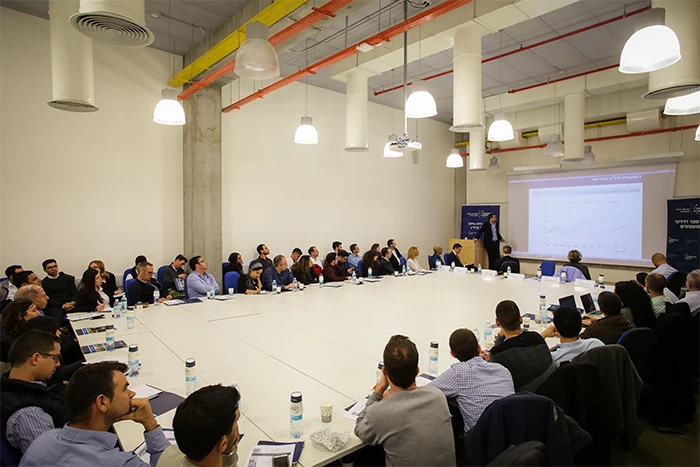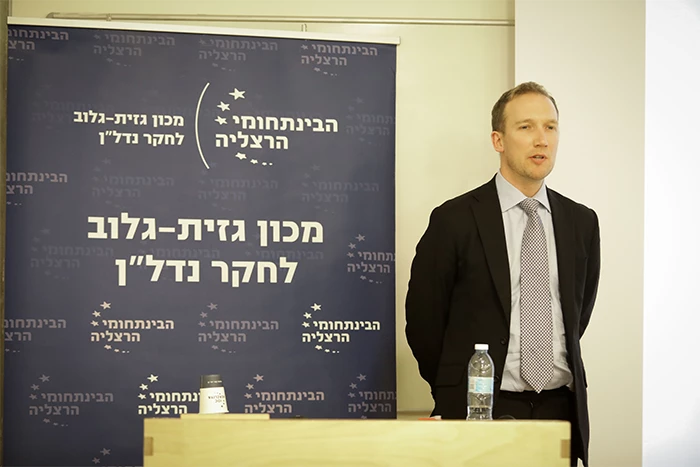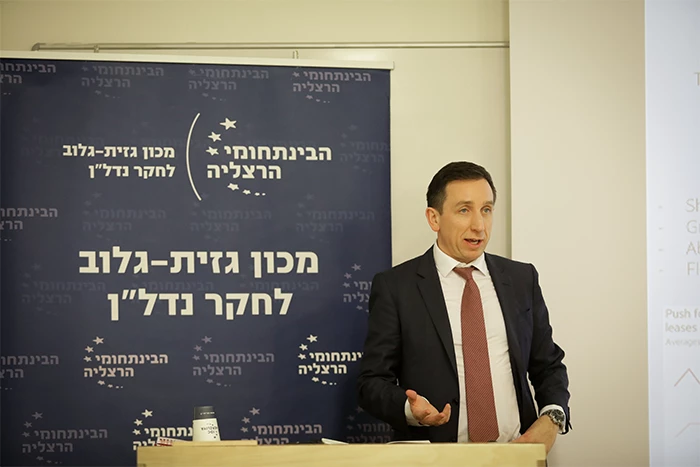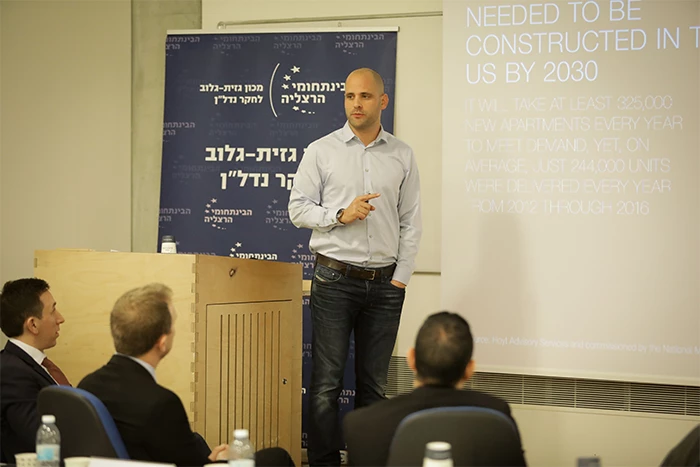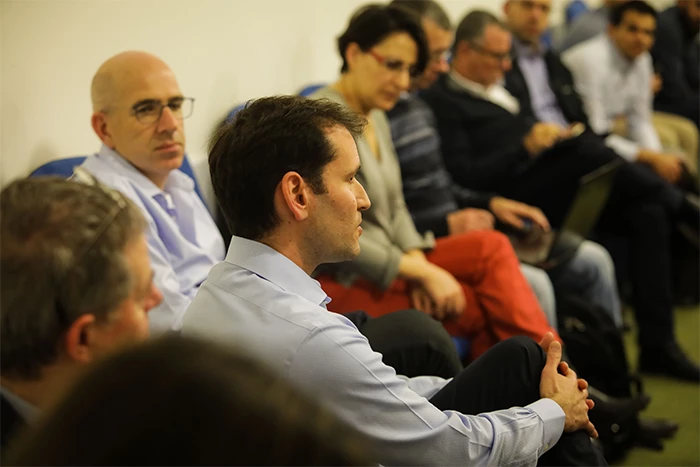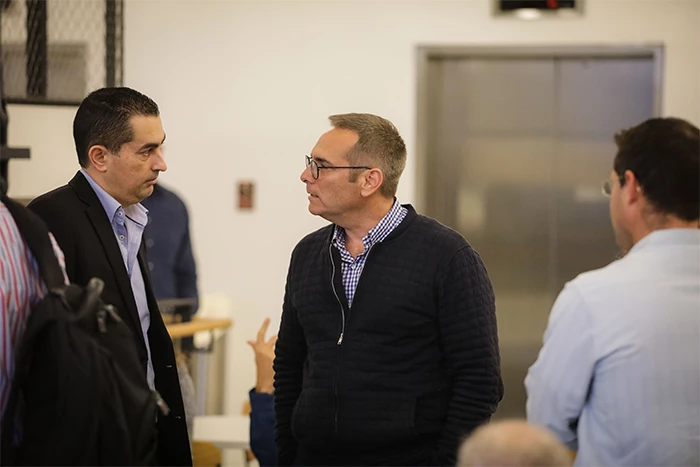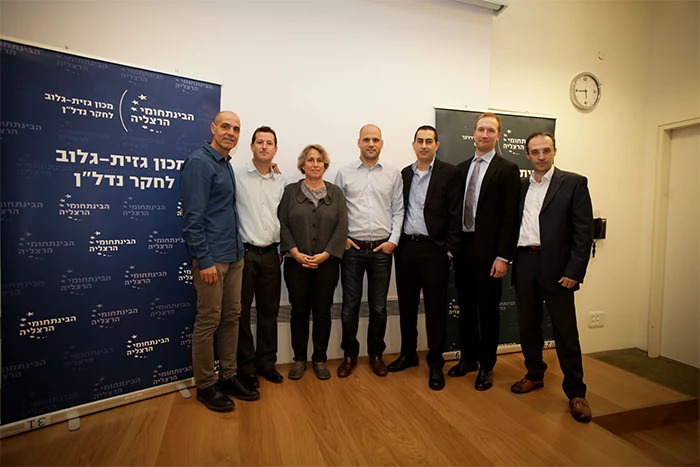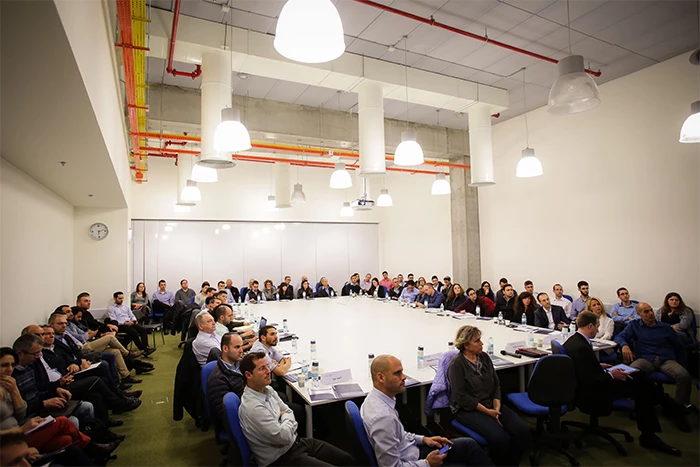
On February 19, 2018, the Gazit-Globe Real Estate Institute held a financial forum on "Trends in Investment Property Around the World." The meeting was attended by senior executives of investment funds, insurance and pension companies, real estate companies, representatives of the Israel Securities Authority, accounting firms, analysts and others.
Dudi Daniel, Vice President and Head of Real Estate at Psagot Investment House, led the meeting, providing an overview of global trends in income-producing real estate. He opened his presentation by discussing the US market, quoting the volume of transactions in US offices for 2017 at about $132 billion -- about a 15% decrease from the previous year, mostly due to decreases in prime assets in main city centers. This, in turn, drove investors seeking high returns to secondary cities, such as Dallas and Atlanta, and to properties located in the suburbs.
With respect to the US residential rental market, he said that the volume of transactions in 2017 amounted to about $150 billion, a decline of about 7% from the previous year, adding that YARDI (real estate systems software) predicts that rental prices for the multi-family residential rental market in the US will continue to rise in the coming years.
Regarding the activity of various market sectors in the US, he pointed out that traditional sectors have significantly decreased over the past year. Retail, particularly in the US, has suffered, as evidenced by a decline of business activity.
He went on to comment on real estate investment in the European market, enumerating several political processes that are affecting the European economy; the European economy it continuing to recover and to present a high growth rate of 2.5% in comparison to previous years. Britain is gearing up for Brexit, and a new president in France is stimulating the economy and planting hope for investors and companies. Catalonia is interested in separating from Spain, Germany has a new government, and Italy has elections coming up.
The total number of income-producing real estate transactions in Europe amounted to €290 billion in 2017 -- an increase of 9% from the previous year. In the UK, the volume of transactions amounted to about €72 billion -- approximately a quarter of total real estate investment in Europe -- and an increase of 12% from the previous year. In Germany the volume of transactions amounted to about €57 billion, an increase of 8% from the previous year. France, in light of the change of government, ended a strong fourth quarter with an investment of €27 billion, with the Netherlands emerging as the greatest surprise of 2017, with €19.5 billion worth of deals, an increase of 43% from the previous year.
Regarding investment in various sectors in Europe, Daniel said that the leading sector in 2017 was, as per usual, the office space sector, which attracted an investment amount of €115 billion. Investor analysis, however, indicates a trend of increased investment in secondary sectors like logistics and industry, with an investment of €42 billion in 2017 - an increase of almost 70% from the previous year.
Daniel said that a study conducted by PWC and ULI listing the top preferred cities in Europe for real estate investors to invest in in 2018 identified four German cities at the top of the list - Frankfurt, Munich, Hamburg and Berlin - in addition to Copenhagen and Madrid. The study also found a change in the preferred sectors of real estate investors in Europe in 2018 - whereas activity has historically been concentrated in the office space and retail sectors, today, activity is concentrated in secondary sectors, with logistics topping the list, and student dormitories in fourth place.
He also described how the increasing volume of purchases made on the Internet is impacting the world of commerce: for example, in the US and Britain, the dramatic increase in online shopping in recent years has negatively impacted activity in commercial centers and shopping malls. He also addressed the co-working trend that has continued to develop in the office space sector. Just three years after first setting up shop in the UK, WeWork is already London’s largest tenant outside of the British government, responsible for about 20% of London's rental activity in 2017. The “WeWork effect” means that renters are signing lease agreements for shorter time periods compared to lease durations in the past. Similarly, large companies, particularly technology-based ones, are opening offices in shared workspaces, and real estate companies in the office space sector are increasingly investing in operators of shared workspace.
In conclusion, Daniel observed that low interest rates and a rise in growth rates have continued to stimulate real estate investment around the world, with the volume of investment in Europe increasing at the expense of US investment. The search for high returns has driven investors to secondary cities and secondary sectors at the expense of primary cities. The increase in online shopping will continue to deflate the trade sector and will attract investors to the logistics sector. Co-work space companies will continue to expand, with the UK real estate market holding particular interest over the next two years.
Daniel Even Zur, Real Estate Asset Manager at Psagot Investment House, identified the logistics sector as the "star sector," the most sought-after sector among real estate investors worldwide. Total investments in this sector in Europe in 2017 amounted to approximately €42 billion - an almost 70% increase from the previous year. The US is considered the largest logistics market in the world, with investments of about $50 billion, followed by Britain, ranking second, with investments of about $8 billion. The significant increase in online shopping has increased the need for logistics centers.
Even Zur also commented on the high demand for the student dormitories sector. Once considered a niche sector, student dormitories have been a rising trend in recent years, marked by the entry of large investors (insurance and pension). In the past three years, the volume of investments worldwide has doubled to about $16 billion a year, with the largest markets being the US and Britain.
Linus Forsberg and Edmund Costello, partners at Trinova Real Estate (London) reviewed the salient trends in the UK office market, highlighting that the UK retail sector is experiencing difficulty, the logistics sector is in high demand, and the industrial sector is seeing high pricing, this due mainly to logistics. They also pointed out that the student dormitories sector is witnessing growing demand among institutional investors. They said that Brexit’s effect on the office space market was less substantial than expected, while other structural factors did affect the market – these include co-working, technology, automation and economic cycles.
According to Forsberg and Costello, the British real estate market, especially the office space sector, is experiencing a decline in prices that is expected to continue for the near future, and therefore many investment opportunities are expected to be had.
Mr. Daniel Zabar, Managing Partner of the Forma Fund, commented on the commercial real estate market in Holland and Italy and said that the Dutch economy is currently recovering from the 2008-2010 crisis, but that real estate prices are still significantly lower than the peak and yields are higher than in other Western European countries. According to an analysis by Knight Frank, rental prices in major cities in the Netherlands and Italy are expected to rise. In 2017, the trend of recovery in the Dutch real estate market continued, especially in the office space market, which accounts for more than 40% of the market.
Referring to the Italian market, he said that Italy is the fourth largest economy in Europe and the eighth largest in the world. There is a huge gap between northern Italy and Rome (a developed economy) to southern Italy, and between the (prosperous) private sector to the governmental sector. In 2017, the real estate market in Rome and Milan continued to recover.
Attorney Gil Rushinek, CEO of Electra Real Estate, presented the multi-family market in the US. In his opinion, this sector makes an attractive investment because it has high demand and low supply. As a result, rental prices continue to rise while the cap rate remains low.
Furthermore, in this sector, the investor enjoys a significant flow of income on an ongoing basis, and there is also the possibility of creating value by renovating apartments and raising rents. Rushinek noted when investing in this sector, which requires significant operational capabilities, it is important to connect with entities with significant experience in managing multi-family assets.
Lior Mor, Vice President of Silverstein Properties, discussed the real estate market in Manhattan and said that New York is a "safe paradise" that behaves differently from the rest of the US. Demand always exists. Even if you need to lower prices, you can always sell or rent. Today, prices in Manhattan are very high. Good assets in the office market are traded at 3% -4% Cap Rate and buyers rely on future appreciation. Manhattan still has many investors from the Far East, Europe, and American pension funds. The Manhattan office market is witnessing an interesting trend. While the Midtown area has historically been the strongest, two new outlying areas have become very strong and influential in the market - the world trade area, where many prestigious offices are being built along with a highly developed transportation center, and the Hudson Yard area on the west side of Manhattan, where a prestigious multi-facility complex has been built. Both of these areas are diverting investment from Midtown and are in high demand.
Mor also referred to the change in the nature of the tenants and their tastes. The workforce is now catering to millennials, for whom flexibility at work is important. WeWork is successful because of the growth of the economy, but also because the tenants have changed and they prefer flexible and modern design. At the same time, because in his opinion real estate is a long-term business, he believes in the combination of products - modern office space for tenants alongside long-term relationships between tenants and landlords.
He later discussed retail in Manhattan, saying that it is mainly “street retail,” which is suffering. Although it depends on the area, one can see, for example, empty shops along the southern part of Fifth Avenue, something that was not the case in the past. There is a shortage of tenants and the vacancy rate in the southern part of Fifth Avenue is 35%.
Mor finished off by speaking about the residential market, saying that the two markets - owned and rented apartments - have risen significantly in recent years. However, the last year has witnessed an over-supply of luxury apartments and the market is relatively frozen. On the other hand, there is a demand for residential apartments that are not luxury apartments, as is the case in the residential rental market. In addition, there has been a steady rise in revenues in the residential rental market. He also said rent levels in Manhattan are pouring into Brooklyn and New Jersey, which are secondary markets to Manhattan.
In conclusion, Dudi Daniel mentioned the percentage of investment in real estate out of the total investments of the institutional bodies, and said that the Ministry of Finance has set a limit of 15%, which the institutional bodies do not reach. In general, it can be said that in insurance and pensions, the goal is to reach 10% investment in real estate, whereas in the provident funds, the goal is 5% since these funds are more liquid.

















